SLIC Watch provides a CloudWatch Dashboard and Alarms for:
- AWS Lambda
- API Gateway
- DynamoDB
- Kinesis Data Streams
- SQS Queues
- Step Functions
Currently, SLIC Watch is available as a Serverless Framework plugin.
- 📦 Install the plugin:
npm install serverless-slic-watch-plugin --save-dev
- 🖋️ Add the plugin to the
pluginssection ofserverless.yml:
plugins:
- serverless-slic-watch-plugin
- 🪛 Optionally, add some configuration for the plugin to the
custom -> slicWatchsection ofserverless.yml. Here, you can specify a reference to the SNS topic for alarms. This is optional, but it's usually something you want so you can receive alarm notifications via email, Slack, etc.
custom:
slicWatch:
topicArn: {'Fn::Ref': myTopic}
See the Configuration section below for more detailed instructions on fine tuning SLIC Watch to your needs.
- 🚢 Deploy your application in the usual way, for example:
sls deploy
- 👀 Head to the CloudWatch section of the AWS Console to check out your new dashboards 📊 and alarms ⏰ !
CloudWatch Alarms and Dashboard widgets are created for all supported resources in the CloudFormation stack generated by The Serverless Framework. This includes generated resources as well as resources specifed explicitly in the resources section.
Any feature can be configured or disabled completely - see the section on configuration to see how.
Lambda Function alarms are created for:
- Errors
- Throttles, as a percentage of the number of invocations
- Duration, as a percentage of the function's configured timeout
- Invocations, disabled by default
- IteratorAge, for function's triggered by an Event Source Mapping
Lambda dashboard widgets show:
| Errors | Throttles | Duration Average, P95 and Maximum |
|---|---|---|
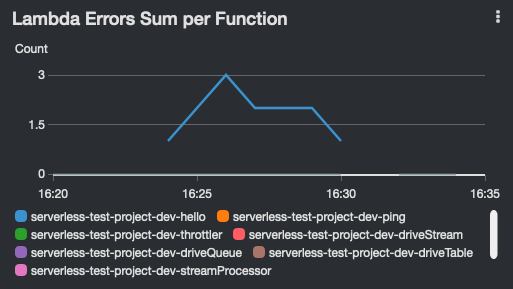 |
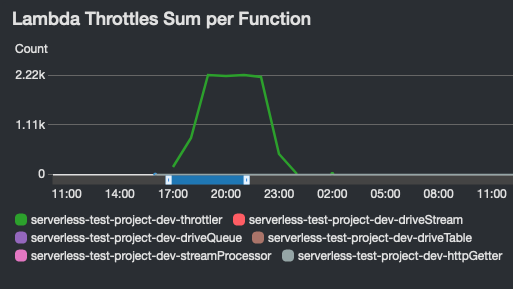 |
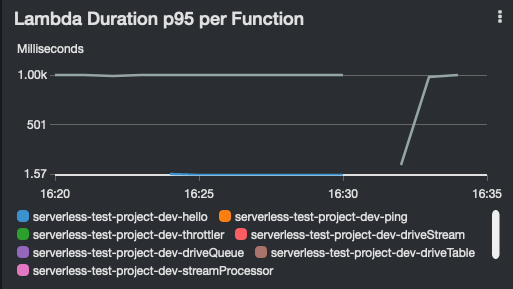 |
| Invocations | Concurrent Executions | Iterator Age |
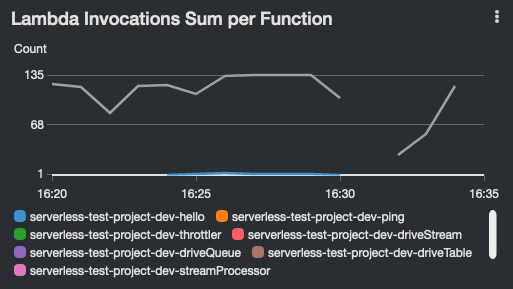 |
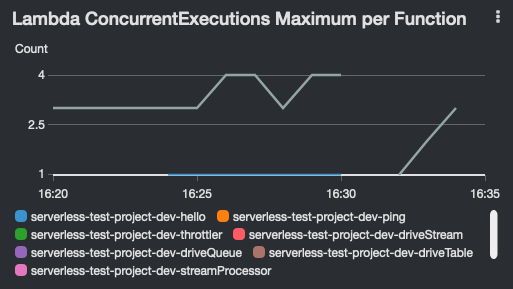 |
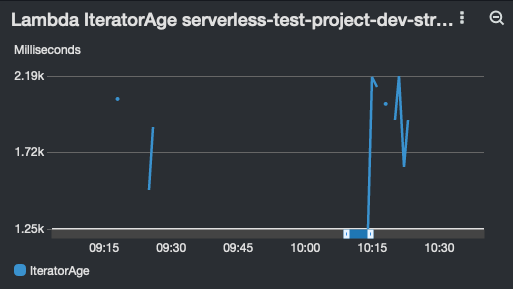 |
API Gateway alarms are created for:
- 5XX Errors
- 4XX Errors
- Latency
API Gateway dashboard widgets show:
| 5XX Errors | 4XX Errors | Latency | Count |
|---|---|---|---|
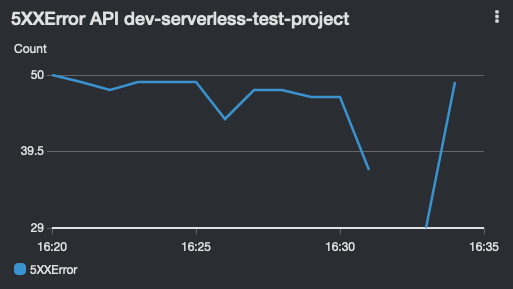 |
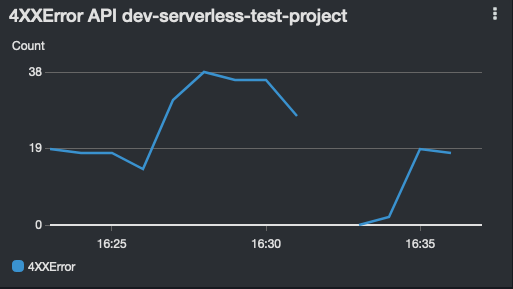 |
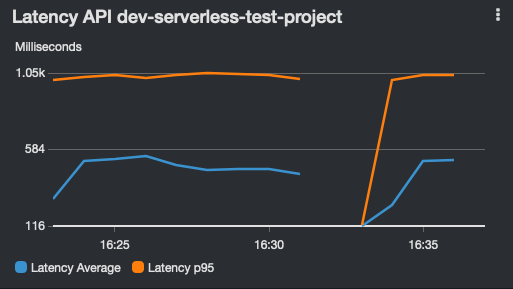 |
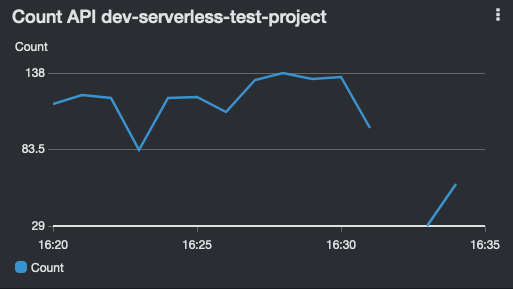 |
DynamoDB alarms are created for:
- Read Throttle Events (Table and GSI)
- Write Throttle Events (Table and GSI)
- UserErrors
- SystemErrors
Dashboard widgets are created for tables and GSIs: dynamodbGSIReadThrottle.png dynamodbGSIWriteThrottle.png dynamodbTableWriteThrottle.png
| ReadThrottleEvents (Table) | WriteThrottleEvent (Table) |
|---|---|
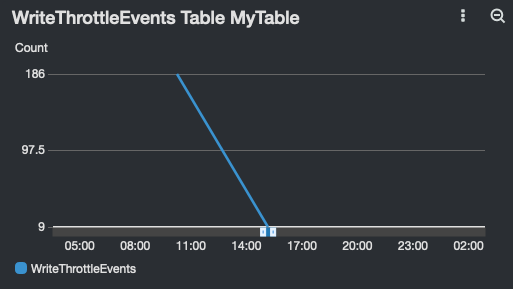 |
 |
| ReadThrottleEvents (GSI) | WriteThrottleEvent (GSI) |
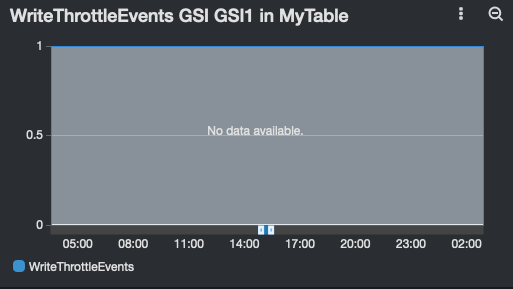 |
 |
Kinesis data stream alarms are created for:
- Iterator Age
- Read Provisioned Throughput Exceeded
- Write Provisioned Throughput Exceeded
- PutRecord.Success
- PutRecords.Success
- GetRecords.Success
Kinesis data stream dashboard widgets show:
| Iterator Age | Read Provisioned Throughput Exceeded | Write Provisioned Throughput Exceeded |
|---|---|---|
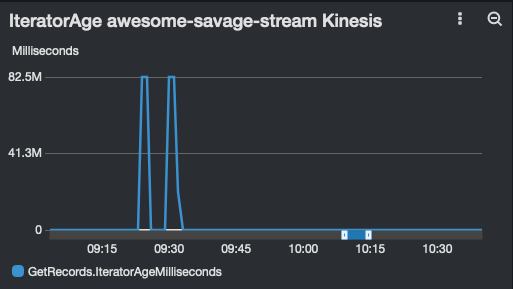 |
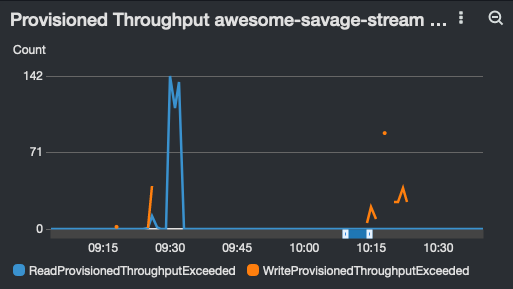 |
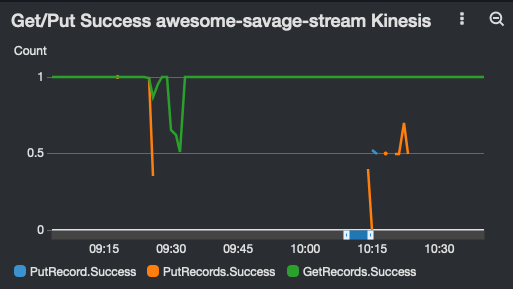 |
SQS Queue alarms are create for:
- Age Of Oldest Message (disabled by default). If enabled, a threshold in seconds should be specified.
- In Flight Messages Percentage. This is a percentage of the AWS hard limits (20,000 messages for FIFO queues and 120,000 for standard queues).
SQS queue dashboard widgets show:
| Messages Sent, Received and Deleted | Messages Visible | Age of Oldest Message |
|---|---|---|
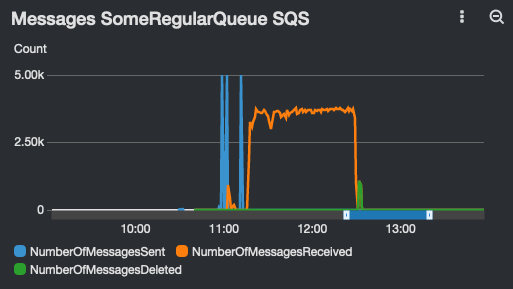 |
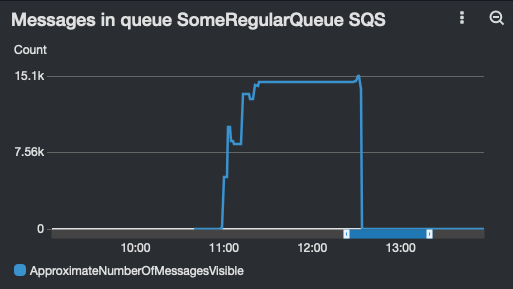 |
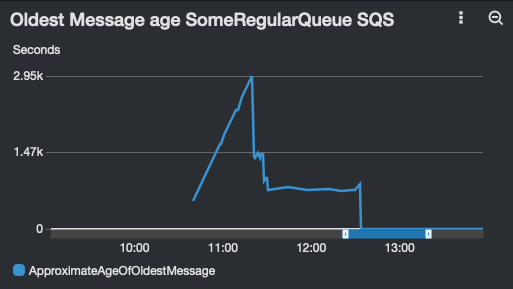 |
Step Function alarms are created for:
- Execution Throttled
- Executions Failed
- Executions Timed Out
The dashboard contains one widget per Step Function:
| ExecutionsFailed ExecutionThrottled, ExecutionsTimedOut |
|---|
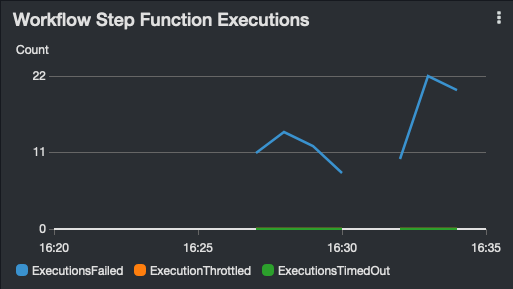 |
Configuration is entirely optional - SLIC Watch provides defaults that work out of the box.
Note: Alarm configuration is cascading. This means that configuration properties are automatically propagated from parent to children nodes (unless an override is present at the given node).
You can customize the configuration:
- at the top level, for all resources in each service, and/or
- at the level of individual functions.
Top-level plugin configuration can be specified in the custom → slicWatch section of serverless.yml
- The
topicArnmay be optionally provided as an SNS Topic destination for all alarms. If you omit the topic, alarms are still created but are not sent to any destination. - Alarms or dashboards can be disabled at any level in the configuration by adding
enabled: false. You can even disable all plugin functionality by specifyingenabled: falseat the top-level plugin configuration.
Supported options along with their defaults are shown below.
# ...
custom:
slicWatch:
topicArn: SNS_TOPIC_ARN # This is optional but recommended so you can receive alarms via email, Slack, etc.
enabled: true
alarms:
enabled: true
Period: 60
EvaluationPeriods: 1
TreatMissingData: notBreaching
ComparisonOperator: GreaterThanThreshold
Lambda: # Lambda Functions
Errors:
Threshold: 0
Statistic: Sum
ThrottlesPc: # Throttles are evaluated as a percentage of invocations
Threshold: 0
DurationPc: # Duration is evaluated as a percentage of the function timeout
Threshold: 95
Statistic: Maximum
Invocations: # No invocation alarms are created by default. Override threshold to create alarms
enabled: false # Note: this one requires both `enabled: true` and `Threshold: someValue` to be effectively enabled
Threshold: null
Statistic: Sum
IteratorAge:
Threshold: 10000
Statistic: Maximum
ApiGateway: # API Gateway REST APIs
5XXError:
Statistic: Average
Threshold: 0
4XXError:
Statistic: Average
Threshold: 0.05
Latency:
ExtendedStatistic: p99
Threshold: 5000
States: # Step Functions
Statistic: Sum
ExecutionsThrottled:
Threshold: 0
ExecutionsFailed:
Threshold: 0
ExecutionsTimedOut:
Threshold: 0
DynamoDB:
# Consumed read/write capacity units are not alarmed. These should either
# be part of an auto-scaling configuration for provisioned mode or should be automatically
# avoided for on-demand mode. Instead, we rely on persistent throttling
# to alert failures in these scenarios.
# Throttles can occur in normal operation and are handled with retries. Threshold should
# therefore be configured to provide meaningful alarms based on higher than average throttling.
Statistic: Sum
ReadThrottleEvents:
Threshold: 10
WriteThrottleEvents:
Threshold: 10
UserErrors:
Threshold: 0
SystemErrors:
Threshold: 0
Kinesis:
GetRecords.IteratorAgeMilliseconds:
Statistic: Maximum
Threshold: 10000
ReadProvisionedThroughputExceeded:
Statistic: Maximum
Threshold: 0
WriteProvisionedThroughputExceeded:
Statistic: Maximum
Threshold: 0
PutRecord.Success:
ComparisonOperator: LessThanThreshold
Statistic: Average
Threshold: 1
PutRecords.Success:
ComparisonOperator: LessThanThreshold
Statistic: Average
Threshold: 1
GetRecords.Success:
ComparisonOperator: LessThanThreshold
Statistic: Average
Threshold: 1
SQS:
# approximate age of the oldest message in the queue above threshold: messages aren't processed fast enough
AgeOfOldestMessage:
Statistic: Maximum
enabled: false # Note: this one requires both `enabled: true` and `Threshold: someValue` to be effectively enabled
Threshold: null
# approximate number of messages in flight above threshold (in percentage of hard limit: 120000 for regular queues and 20000 for FIFO queues)
InFlightMessagesPc:
Statistic: Maximum
Threshold: 80 # 80% of 120.000 for regular queues or 80% of 20000 for FIFO queues
dashboard:
enabled: true
timeRange:
# For possible 'start' and 'end' values, see
# https:# docs.aws.amazon.com/AmazonCloudWatch/latest/APIReference/CloudWatch-Dashboard-Body-Structure.html
start: -PT3H
metricPeriod: 300
widgets:
metricPeriod: 300
width: 8
height: 6
Lambda:
# Metrics per Lambda Function
Errors:
Statistic: ['Sum']
Throttles:
Statistic: ['Sum']
Duration:
Statistic: ['Average', 'p95', 'Maximum']
Invocations:
Statistic: ['Sum']
ConcurrentExecutions:
Statistic: ['Maximum']
IteratorAge:
Statistic: ['Maximum']
ApiGateway:
5XXError:
Statistic: ['Sum']
4XXError:
Statistic: ['Sum']
Latency:
Statistic: ['Average', 'p95']
Count:
Statistic: ['Sum']
States:
# Step Functions
ExecutionsFailed:
Statistic: ['Sum']
ExecutionsThrottled:
Statistic: ['Sum']
ExecutionsTimedOut:
Statistic: ['Sum']
DynamoDB:
# Tables and GSIs
ReadThrottleEvents:
Statistic: ['Sum']
WriteThrottleEvents:
Statistic: ['Sum']
Kinesis:
# Kinesis Data Streams
GetRecords.IteratorAgeMilliseconds:
Statistic: ['Maximum']
ReadProvisionedThroughputExceeded:
Statistic: ['Sum']
WriteProvisionedThroughputExceeded:
Statistic: ['Sum']
PutRecord.Success:
Statistic: ['Average']
PutRecords.Success:
Statistic: ['Average']
GetRecords.Success:
Statistic: ['Average']
SQS:
# SQS Queues
NumberOfMessagesSent:
Statistic: ["Sum"]
NumberOfMessagesReceived:
Statistic: ["Sum"]
NumberOfMessagesDeleted:
Statistic: ["Sum"]
ApproximateAgeOfOldestMessage:
Statistic: ["Maximum"]
ApproximateNumberOfMessagesVisible:
Statistic: ["Maximum"]An example project is provided for reference: serverless-test-project
For each function, add the slicWatch property to configure specific overrides for alarms and dashboards relating to the AWS Lambda Function resource.
functions:
hello:
handler: basic-handler.hello
slicWatch:
dashboard:
enabled: false # No Lambda widgets will be created for this function
alarms:
Lambda:
Invocations:
Threshold: 2 # The invocation threshold is specific to
# this function's expected invocation countTo disable all alarms for any given function, use:
functions:
hello:
handler: basic-handler.hello
slicWatch:
alarms:
Lambda:
enabled: falseThis plugin creates additional CloudWatch resources that, apart from a limited free tier, have an associated cost. Depending on what you enable, SLIC Watch creates one dashboard and multiple alarms. The number of each depend on the number of resources in your stack and the number of stacks you have.
Check out the AWS CloudWatch Pricing page to understand the cost impact of creating CloudWatch resources.
- serverless-plugin-aws-alerts
- Real World Serverless Application - Serverless Operations
- CDK Watchful
- CDK Patterns - The CloudWatch Dashboard
- AWS Well Architected Serverless Applications Lens
- How to Monitor Lambda with CloudWatch Metrics - Yan Cui
Apache - LICENSE

